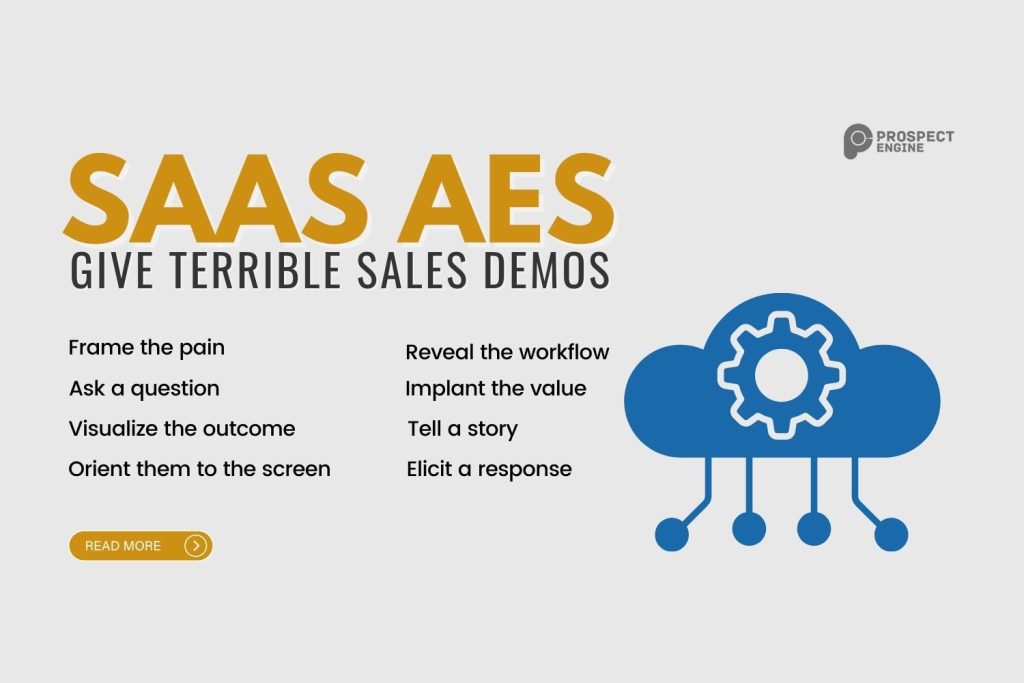Sales demos are critical for Software as a Service (SaaS) firms to convert leads into paying customers. Shockingly, a whopping 97% of SaaS Account Executives (AEs) deliver terrible sales demos, presenting a significant hurdle. This can cause missed opportunities and lost revenue. In this article, we’ll delve into why this problem persists and offer solutions to help SaaS AEs enhance their sales demos.
You either risk causing boredom to your buyers at the very least or, at worst, you may even end up irritating them.
Want to be in the 3%?
This 8-step framework can help you deliver SaaS demos that are exceptionally effective in driving sales.
The acronym F.A.V.O.R.I.T.E. stands for:
F – Frame the pain.
In SaaS demos, it’s crucial to identify the pain point that each feature solves to demonstrate it effectively. Restating the pain statement before showcasing each feature can be beneficial, not just at the beginning of the demo.
For example, you mentioned earlier that you were facing challenges with…
A – Ask a question.
Once the pain point has been introduced, it can be helpful to ask a pain-oriented question that further emphasizes how the feature will address the problem. One effective question to follow up with after the pain statement is, “How are you currently managing that issue?”
This type of question helps highlight the pain point and encourages the listener to reflect on their current approach to the problem, making them more receptive to the feature being demonstrated.
V – Visualize the outcome.
Before jumping into a demo, it’s important to establish the feature’s value by helping your customer visualize its benefits. You can accomplish this by creating a scenario that allows the customer to imagine themselves using the feature.
For example, you might say something like, “Picture this – what if you could onboard new reps twice as fast by allowing them to binge-watch demo recordings? Well, that’s exactly what I’m about to demonstrate for you…”
By creating a vivid picture in the customer’s mind, you’re able to establish the value of the feature and get them excited to see it in action.
O – Orient them to the screen.
Now that the value of the feature has been established, it’s important to take a few seconds to ensure that your buyer understands what they see on the screen share. This can be achieved by providing a brief overview or explanation of the interface so that they can follow along with the demo more easily.
By getting your buyer up to speed on what they’re looking at, you can avoid confusion or misinterpretation and help them appreciate the benefits of the feature being demonstrated fully.
R – Reveal the workflow.
This is the part where you demonstrate the feature in the traditional sense. Show your buyer the
workflow the feature enables, and explain how it addresses the pain point you established earlier.
By showcasing the feature in action and demonstrating its benefits, you can help your buyer better understand how it works and can be used to address their specific pain points.
I – Implant the value.
Did you notice something? When you demonstrate a feature, it’s important to surround it with value. This means starting and ending the feature demo with value statements.
After showcasing the workflow, be sure to restate the value statement. For example, you might say something like, “By using this feature, you’ll be able to onboard new reps twice as fast, resulting in a significant increase in productivity.”
By reinforcing the value of the feature at the beginning and end of the demo, you can help your buyer fully understand its benefits and make an informed decision about whether it’s the right solution for their needs.
T – Tell a story.
Studies have shown that people tend to remember stories more easily than click paths. Once you’ve demonstrated your feature and established its value, consider sharing a success story about how another customer uses it to achieve positive outcomes.
By sharing a real-life example of how the feature has helped another customer to succeed, you can help your buyer to visualize how they might use it in their own business. This can be a powerful way to reinforce the value of the feature and increase the buyer’s confidence in their decision to purchase it.
Overall, incorporating success stories into your demos can be an effective way to help your buyers understand how your product or service can help them achieve their goals.
E – Elicit a response.
You’re almost finished with the demo. Now, it’s a good time to ask a post-feature question to encourage your buyer to engage in conversation. One effective question to ask is, “How does this compare to how you’re currently addressing this issue?”
By asking this question, you can gain valuable insights into the buyer’s current approach and help them to reflect on how the feature you’ve demonstrated can improve their situation.
I hope this advice is helpful to you. Give it a try in your next demo and see how it works for you! Learn More.





